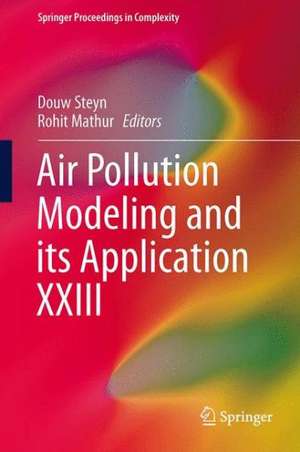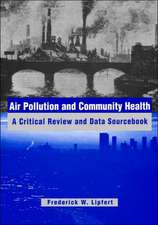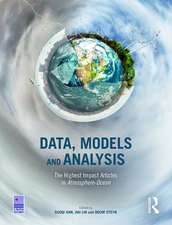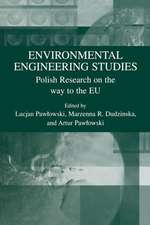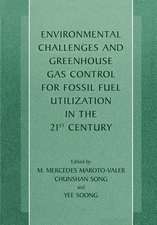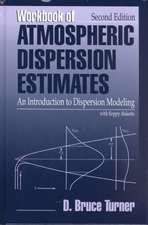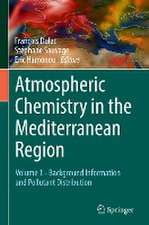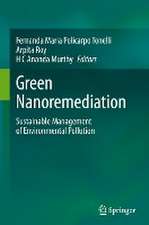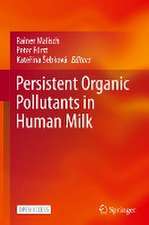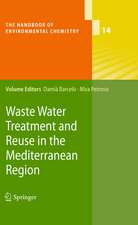Air Pollution Modeling and its Application XXIII: Springer Proceedings in Complexity
Editat de Douw Steyn, Rohit Mathuren Limba Engleză Hardback – 22 mai 2014
| Toate formatele și edițiile | Preț | Express |
|---|---|---|
| Paperback (1) | 1234.77 lei 6-8 săpt. | |
| Springer International Publishing – 17 sep 2016 | 1234.77 lei 6-8 săpt. | |
| Hardback (1) | 1251.98 lei 6-8 săpt. | |
| Springer International Publishing – 22 mai 2014 | 1251.98 lei 6-8 săpt. |
Din seria Springer Proceedings in Complexity
- 20%
 Preț: 1128.81 lei
Preț: 1128.81 lei - 18%
 Preț: 1240.16 lei
Preț: 1240.16 lei - 18%
 Preț: 1214.09 lei
Preț: 1214.09 lei -
 Preț: 497.14 lei
Preț: 497.14 lei - 18%
 Preț: 1112.30 lei
Preț: 1112.30 lei - 18%
 Preț: 1300.10 lei
Preț: 1300.10 lei - 20%
 Preț: 1084.83 lei
Preț: 1084.83 lei - 18%
 Preț: 1393.27 lei
Preț: 1393.27 lei - 18%
 Preț: 961.55 lei
Preț: 961.55 lei - 20%
 Preț: 646.95 lei
Preț: 646.95 lei - 15%
 Preț: 641.71 lei
Preț: 641.71 lei - 18%
 Preț: 1395.32 lei
Preț: 1395.32 lei - 18%
 Preț: 952.89 lei
Preț: 952.89 lei - 20%
 Preț: 646.12 lei
Preț: 646.12 lei - 20%
 Preț: 571.28 lei
Preț: 571.28 lei - 20%
 Preț: 1288.76 lei
Preț: 1288.76 lei - 18%
 Preț: 1125.55 lei
Preț: 1125.55 lei - 15%
 Preț: 643.34 lei
Preț: 643.34 lei - 18%
 Preț: 947.04 lei
Preț: 947.04 lei - 24%
 Preț: 839.40 lei
Preț: 839.40 lei - 18%
 Preț: 1670.11 lei
Preț: 1670.11 lei - 18%
 Preț: 1223.25 lei
Preț: 1223.25 lei - 18%
 Preț: 974.04 lei
Preț: 974.04 lei - 15%
 Preț: 646.11 lei
Preț: 646.11 lei - 18%
 Preț: 1225.16 lei
Preț: 1225.16 lei - 15%
 Preț: 645.79 lei
Preț: 645.79 lei - 18%
 Preț: 957.32 lei
Preț: 957.32 lei - 20%
 Preț: 984.18 lei
Preț: 984.18 lei - 15%
 Preț: 643.84 lei
Preț: 643.84 lei - 15%
 Preț: 644.63 lei
Preț: 644.63 lei - 18%
 Preț: 1236.51 lei
Preț: 1236.51 lei - 18%
 Preț: 1223.25 lei
Preț: 1223.25 lei - 18%
 Preț: 964.86 lei
Preț: 964.86 lei - 18%
 Preț: 1278.82 lei
Preț: 1278.82 lei - 18%
 Preț: 1217.41 lei
Preț: 1217.41 lei - 24%
 Preț: 1067.25 lei
Preț: 1067.25 lei -
 Preț: 424.99 lei
Preț: 424.99 lei - 18%
 Preț: 1236.69 lei
Preț: 1236.69 lei - 20%
 Preț: 1277.57 lei
Preț: 1277.57 lei -
 Preț: 424.81 lei
Preț: 424.81 lei - 24%
 Preț: 1084.92 lei
Preț: 1084.92 lei
Preț: 1251.98 lei
Preț vechi: 1526.81 lei
-18% Nou
Puncte Express: 1878
Preț estimativ în valută:
239.60€ • 249.22$ • 197.80£
239.60€ • 249.22$ • 197.80£
Carte tipărită la comandă
Livrare economică 14-28 aprilie
Preluare comenzi: 021 569.72.76
Specificații
ISBN-13: 9783319043784
ISBN-10: 3319043781
Pagini: 680
Ilustrații: XXXVIII, 640 p. 209 illus., 8 illus. in color.
Dimensiuni: 155 x 235 x 42 mm
Greutate: 1.43 kg
Ediția:2014
Editura: Springer International Publishing
Colecția Springer
Seria Springer Proceedings in Complexity
Locul publicării:Cham, Switzerland
ISBN-10: 3319043781
Pagini: 680
Ilustrații: XXXVIII, 640 p. 209 illus., 8 illus. in color.
Dimensiuni: 155 x 235 x 42 mm
Greutate: 1.43 kg
Ediția:2014
Editura: Springer International Publishing
Colecția Springer
Seria Springer Proceedings in Complexity
Locul publicării:Cham, Switzerland
Public țintă
ResearchCuprins
Part I Air quality and human health.- Use of air quality modeling results in health effects research.- 2 Air quality effects on human health.- 3 Development of model-based air pollution exposure metrics for use in epidemiologic studies.- 4 Improved spatiotemporal air pollutant mixture characterization for health studies.- 5 Advances in linked air quality, farm management and biogeochemistry models to address bidirectional ammonia flux in CMAQ.- 6 A temporal NOx emissions trading system: case study of US power plants.- 7 Source attribution of attainment and exposure-based ozone metrics in North America.- 8 CASTNET methodology for modeling dry and total deposition.- 9 ACCEPTED: an Assessment of Changing Conditions, Environmental Policies, Time-activities, Exposure and Disease.- Part II Climate change and air quality.- 10 Studying aerosol-cloud-climate interactions over East Asia using WRF/Chem.- 11 Investigation of trends in aerosol direct radiative effects over North America using a coupled meteorology-chemistry model.- 12 Future year air quality change due to growth in aircraft emissions and changes in climate.- Part III Aerosols in the atmosphere.- 13 The use of a Non Negative Matrix Factorization method combined to PM2.5 chemical data for a source apportionment study in different environments.- 14 On the interplay between upper and ground levels dynamics and chemistry in determining the surface aerosol budget.- 15 Modeling of aerosol indirect effects with WRF/Chem over Europe.- 16 The influence of cloud chemical processes on the formation of secondary particulate matter.- 17 An improved volatility basis set for modeling organic aerosol in both CAMx and CMAQ.- 18 Issues related to on/offline meteorological and atmospheric chemistry model coupling.- 19 Increases in wintertime oxidation capacity counteract the success of emission reduction measures in Europe with respect to secondary inorganic aerosols.- 20 Investigating the contribution of biogenic emissions to the formation of secondary pollutants in Portugal.- 21 Modelling aerosol-cloud-meteorology interaction: a case study with a fully coupled air quality model (GEM-MACH).- 22 Evaluation of cloud chemistry mechanism towards laboratory experiments.- 23 Effects of surf zone sea-spray particles on aerosol concentration in coastal area.- 24 Novel pathways to form secondary organic aerosols: glyoxal SOA in WRF/Chem.- 25 Modeling seasonal changes in organic aerosol composition at the puy de Dôme (France).- 26 Using WRF-CMAQ air quality modelling system to estimate BaP concentrations over Zaragoza (Spain).- 27 The POAEMM project: prediction of spatial and temporal variation of marine aerosols in coastal area.- 28 An integrated Weather and Sea State Forecasting system for the Arabian Peninsula (WASSF).- 29 Modelling past and future changes in secondary inorganic aerosol concentrations in the UK.- Part IV Regional and intercontinental modeling.- 30 Modelling the impact of energy transitions on air quality and source receptor relations.- 31 Impact of mercury chemistry on regional concentration and deposition patterns.- 32 A multiscale modeling study to assess impacts of full-flight aircraft emissions on upper troposphere and surface air quality.- 33 Relevance of photolysis frequencies calculation aspects to the ozone concentration simulation.- 34 Air pollution in China in January 2013.- 35 Impact on Ontario’s air quality due to changes in North American emission from 2005 to 2020.- 36 Modelling the concentration and deposition of heavy metals in the UK.- 37 A process analysis of the impact of air-quality/weather feedbacks using GEM-MACH.- 38 Analog-based postprocessing methods for air quality forecasting.- 39 Comparing different modeling approaches in obtaining regional scale concentration maps.- 40 Impact of RACM2, halogen chemistry and updated ozone deposition velocity on hemispheric ozone predictions.- 41 A global wildfire emission and atmosphericcomposition: refinement of the Integrated System For Wild-Land Fires IS4FIRES.- 42 The regional LOTOS-EUROS model on tour.- 43 The incorporation of the US national emission inventory into version 2 of the Hemispheric Transport of Air Pollutants inventory.- 44 Impact of vertical and horizontal resolutions on chemistry transport modeling.- 45 A model study on the effects of emission reductions on European air quality between 1990 and 2020.- 46 Analysis and modelling of ambient air toxics pollutants in Canada with Environment Canada AURAMS model.- 47 Investigating the coherence between a global and a limited area model for dust particle production and distribution in N. Africa.- 48 Effects of future ship emissions in the North Sea on air quality.- 49 Temporally and spatially resolved air pollution in Georgia using fused ambient monitor data and chemical transport model results.- 50 Maritime sector emissions contribution to the particulate matter pollution in a Mediterranean city-port: A modeling approach.- 51 Application and evaluation of the high-resolution regional scale FRAME model for calculation of ammonia and ammonium air concentrations for Poland for the years 2002-2008.- 52 Regional transports of atmospheric NOx and HNO3 over Cape Town.- 53 The impact of transboundary transport of air pollutants on air quality in the United Kingdom and Poland.- Part V Local and urban scale modeling.- 54 A 40-year history of a simple urban dispersion model and its evaluation.- 55 Assessment of the effect of multiscale interactions on the atmospheric flow and the dispersion of air pollution in the city of Paris.- 56 PAHs modelling over urban area of Rome: integration of models results with experimental data.- 57 Modelling the effects of urban morphology, traffic and pedestrian dynamics on students’ exposure to air pollution.- 58 LES of advective and turbulent passive scalar fluxes in a street intersection.- 59 Two-phase accidental dense gas releasessimulations with the Lagrangian particle model Microspray.- 60 Modeling of the Urban Heat Island and its effect on air quality using WRF/WRF-Chem – Assessment of mitigation strategies for a central European city.- 61 Assessment of three dynamical urban climate downscaling methods.- 62 Validating the RIO-IFDM street canyon coupling over Antwerp, Belgium.- 63 The influence of the changing NOx-split for compliance to the European limit values in urban areas.- 64 Evaluation of air pollution models for their use in emergency response tools in built environments: the ‘Michelstadt’ case study in COST ES1006 ACTION.- 65 Development of a numerical prediction model system for the assessment of the air quality in Budapest.- 66 Analysis of the differences between pollution levels into a new and an old district of a big city using dispersion simulations at microscale.- 67 Water Tank Simulation of a dense fluid release.- 68 The porosity concept applied to urban canopy improves the results of Gaussian dispersion modelling of traffic-dominated emissions.- 69 An evaluation of the box model estimating carbon monoxide concentration in the city of Caracas, Venezuela.- 70 Implications of vegetation on pollutant dispersion in an idealized urban neighborhood.- Part VI Model assessment and verification.- 71 Dynamic evaluation of the CMAQv5.0 modeling system: Assessing the model’s ability to simulate ozone changes due to NOx emission reductions.- 72 Evaluation of a chemical data assimilation system.- 73 Resolving and quantifying ozone contributions from boundary conditions within regional models.- 74 E pluribus unum: KZ filters and Ensemble Air Quality modeling.- 75 Air quality model evaluation using Gaussian process modelling and empirical orthogonal function decomposition.- 76 AQMEII Phase 2: Overview and WRF-CMAQ Application over North America.- 77 Modelling UK Air Quality for AQMEII2 with the Online Forecast Model AQUM.- 78 Model inter-comparison studybetween NMMB/BSC-CTM and Enviro-HIRLAM on-line systems contributing to the AQMEII-Phase2 initiative.- 79 Can we explain the observed decrease in secondary inorganic aerosol and its precursors between 1990 and 2009 over Europe using LOTOS-EUROS?.- 80 Application and evaluation of high-resolution WRF-CMAQ with simple urban parameterization.- 81 A one year evaluation of the CTM CHIMERE using SURFEX/TEB within the high resolution NWP models ALARO and ALADIN for Belgium.- 82 Application of performance indicators based on observation un-certainty to evaluate a Europe-wide model simulation at urban scale.- 83 Multi-model ensembles: how many models do we need?.- 84 Diagnostic evaluation of NOx emission upgrade on air quality forecast.- 85 Presentation and validation of a new building downwash model.- 86 Boundary-layer and air quality study at “Station Nord” in Greenland.- 87 Evaluation of mesoscale model profiles against consecutive radiosounding data during the Sofia 2003 Experiment.- 88 The use of a mesoscale modeling system together with surface and upper observational data to estimate hourly benzene impacts in a mountainous coastal area.- 89 A sensitivity analysis of the WRF model to shortwave radiation schemes for air quality purposes and evaluation with observational data.- 90 Comparing WRF PBL schemes with experimental data over Northern Italy.- 91 Surface ozone variability in synoptic pattern perspectives.- 92 WRF-Chem model sensitivity analysis to chemical mechanism choice.- Part VII Data assimilation and air quality forecasting.- 93 Assimilation of satellite oceanic and atmospheric products to improve emission forecasting.- 94 Assimilation and forecasting fine aerosols over North America in summer 2012.- 95 Evaluating the vertical distribution of ozone and its relationship to pollution events in air quality models using satellite data.- 96 Building and testing atmospheric chemistry reanalysis modeling system.- 97 Intensive campaigns supported by air qualityforecasting capability to identify chemical and atmospheric regimes susceptible to standard violations.- 98 Modeling of air pollution over the Ganges basin and north-west Bay of Bengal in the early post-monsoon season using the NASA GEOS-5 model.- 99 The impact of a wildland fire on air pollution concentrations using WRF/Chem/Fire: An application over Murcia (Spain).- 100 Assimilation of PM ground measurements: looking for optimal settings for the PM forecasts.- 101 Spatial and temporal extension of a novel hybrid source apportionment model.- 102 Application of data assimilation to the UK Air Quality Forecast.- 103 Improvements to the regional deterministic air quality analysis system for ozone and PM2.5 at the surface at the Canadian Meteorological Center.- 104 Current and future developments in numerical air quality forecasting in Canada.
Textul de pe ultima copertă
Recent developments in air pollution modelling are explored as a series of contributions from researchers at the forefront of their field. This newest contribution on air pollution modelling and its application is focused on local, urban, regional and intercontinental modelling; data assimilation and air quality forecasting; model assessment and evaluation; aerosol transformation. Additionally, this work also examines the relationship between air quality and human health and the effects of climate change on air quality. The work derives from a series of papers presented at the 33rd International Technical Meeting on Air Pollution Modelling and its Application held in Miami, USA, August 27 - 31, 2013. The book is intended as reference material for students and professors interested in air pollution modelling at the graduate level as well as researchers and professionals involved in developing and utilizing air pollution models.
Caracteristici
Latest research results in important applied field Contributions from world leading scientists Comprehensive set of key topics
